Toshihiro Matsui
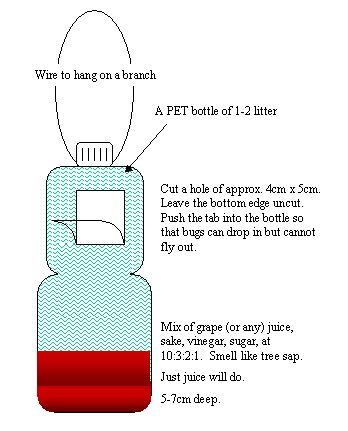
If you are troubled by wasps hanging around your house
or garden, make a simple trap with a PET bottle and catch hundreds of
wasps in a month. The best season is in May and June while queen wasps
are busy hunting food and building hives alone.
Though their main dish is other insects, they also like honey and any sweet. This is a reason we often see wasps even in suburban areas these days: they can easily find sweet juice spilling from dumped cans.
Wasps that are just looking for foods are not very dangerous. It is taught that when a wasp comes in a car cabin, just open windows and it will fly away. But if you approach to their hive, they become very aggressive and lots of soldier wasps come out to attack you unless you leave immediately. In Japan, thirty to forty people are killed by wasp sting, mostly by anaphylaxis shock, not directly by the wasp toxin.
A direct way to reduce such injuries is to remove their hives, but the task is very dangerous. Another way is to catch queen wasps while they are busy working to build hives, before they lay the first eggs. It's surprisingly easy and safe! Make a trap as shown right, and hang it on a tree. Get a PET bottle of 1-2 litter. Make a square hole of 4-5cm edges in the upper part of the bottle. Leave the lower edge uncut. Push the stub into the bottle so wasps can get in but cannot fly out once they dropped to the bottom. Pour approx. 200ml of grape juice, 50ml of vinegar, and some beer or wine. Some people suggest lactic fermentation acid drink is good. Your own recipe is OK as long as it smells good. Hang the bottle on a tree where you sighted wasps. Wait a few hours (to a few weeks if you are unlucky), and wasps are there. Let me call this trap "Wasp-Hoy-Hoy".
| I hang a trap as shown in the right
picture.
As a matter of fact, this location is not so good.
A bit darker locations are better.
But any places you see wasps are OK.
I hang a trap in the end of March. No wasps could be caught for about three weeks. Obviously, it was too early and cold. Wasps were still underground. In the end of April when exceptionally warm days lasted, I found two wasps swimming in the juice pool. |
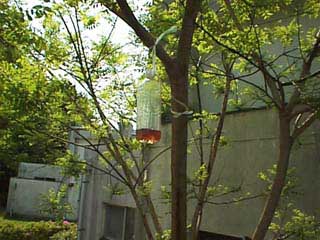 |
||||||||||
| Then in a few days, wasp were caught one by one, day by day. May 1st, I thought there could be eight dead wasps in there. On the next day, I poured the content in a bucket and counted-- |
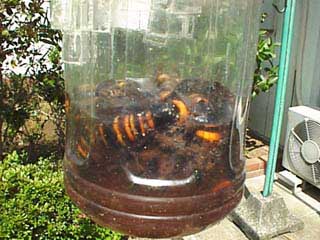 |
||||||||||
| -- fourteen wasps! Do you think they
look tiny? No, most of them are 4.5cm long, and the largest one
was more than 5cm. I believe big ones are all queens.
By the way, I was surprised at the buzz of insects that began flying over me immediately after I opened the "Wasp-Hoy-Hoy". Obviously the smell of the juice carried by wind called up those insects. Last year, my sons caught several beatles. After playing with them for a few days, the boys decided to release them. The next day, we found a few of them in the Wasp-Hoy-Hoy. Sad. |
 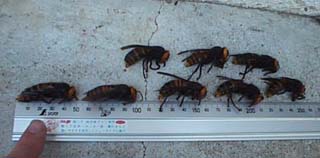 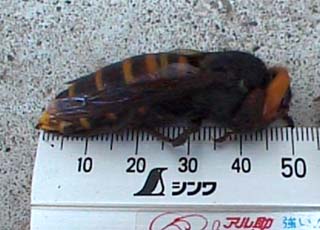 |
||||||||||
| I cleaned the trap, and hang it again
on a tree on May third. It was just a few hours before I found
two writhing wasps.
I hang another wasp-hoy-hoy on a tree on the way to my son's elementary school. It seemed to have caught several. |
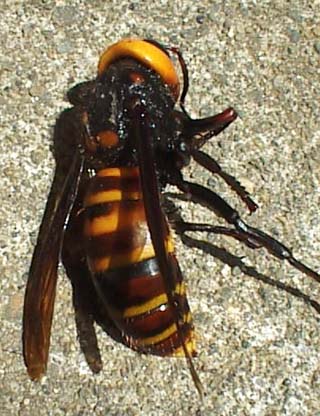 |
||||||||||
After all, the following wasps were
caught during the first week of May. 60-70% were believed to be queens.
I have a hypothesis that queen wasps never sting. Because, first of all, a queen is the most valuable resource in a wasp colony. If it is lost, next generation will not be born. If you play chess or shogi, you know it is a good idea to fight with your king. It has a role to be protected, not to attack. The other reason is that a sting is evolved from an ovipositor (a pipe-like organ to lay eggs), and it is irrational for a queen to have both the ovipositor and a sting. But I don't want to prove this theory. |
 |
||||||||||
| The story does not finish yet. In the evening of 7th, I changed the attraction
liquid. I found several captures in the next morning. This time the increase
was rapid. Since there are so many deads in the bottle, and the liquid
began fermentation producing alchohol and carbon-dioxide, because of the
warm climate these days, they give enough floating lift for a few wasps
to live on them. Therefore, I cannot open the trap. Another trap I installed
on a tree in the school playground has also caught full of wasps as shown
in the picture. Two of them are alive. Do I just wait for their death?
What I learned: put the liquid more than enough to kill 20. Reclaim trap in less than a week. Otherwise, we have to handle live wasps buzzing in the bottle. Finally I counted 53 dead wasps in a single trap! 70% of them were queens. |
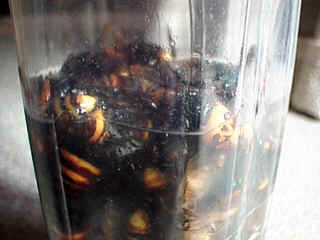 |